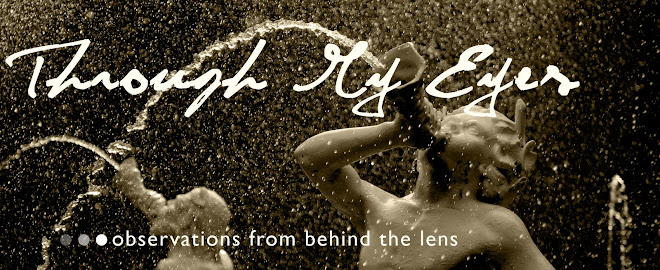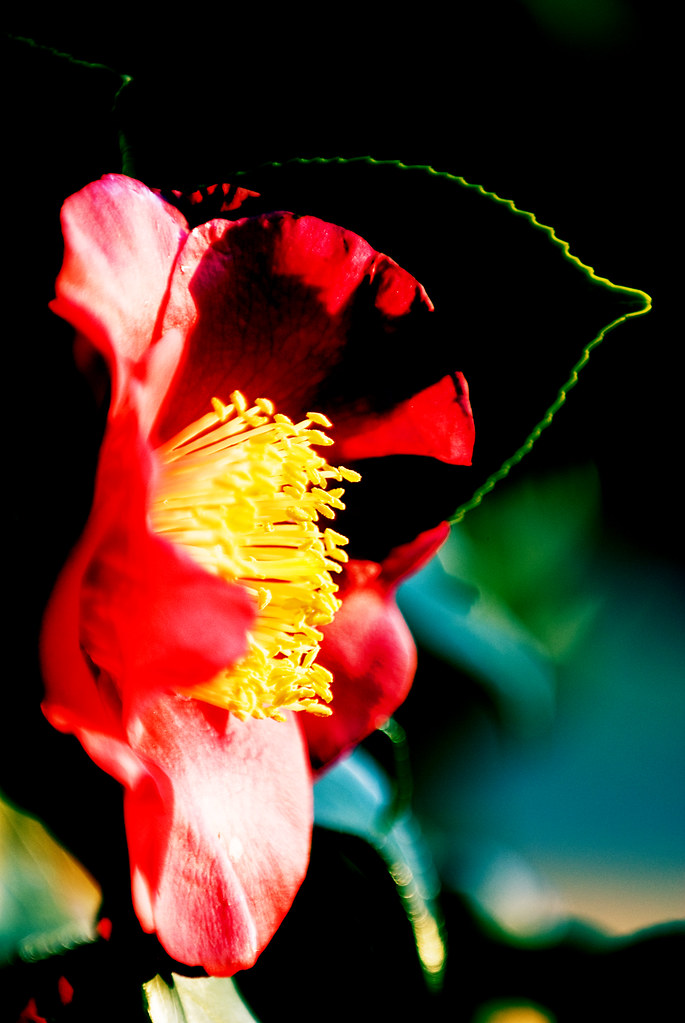I had a few moments after work today to grab the Nikon and take advantage of some great late afternoon lighting. It's been so rainy lately--I'm ready for springtime. The camelias are blooming in my yard. Typically, I'm pretty averse to flower photography. To be appealing, it has to be something different or inspiring. And I'm not really big on lots of Photoshopping images either. But today, I broke both of those practices. I shot this with my 70-200mm, f2.8 to create a nice narrow depth of field image. And what emerged is a high contrast, hyper-saturated and cross processed photo. It is quite a departure from the norm for me--something we can all use from time to time. Relish in the glow of sunshine on these pink petals and bright yellow stamen. Tomorrow is supposed to bring a high of 45 degrees and rain.
Tuesday, February 23, 2010
Thursday, February 18, 2010
Little Ocmulgee State Park
I spent the past weekend at Little Ocmulgee State Park in McRae, Georgia for a church family retreat. I’m embarrassed to say that I was too busy setting up PA equipment and musical instruments to take any photos of the snow, which for a few brief hours made the park quite beautiful before quickly melting. But in the few hours I had of down-time, long after the snow was gone, I discovered some interesting facts about the middle Georgia park that struck a chord with me.
Little Ocmulgee is one of Georgia’s state owned parks, one of eight with lodging and seven with a golf course. It’s definitely not luxurious. And compared to others in Georgia, it’s not even that picturesque. But for some strange reason, I keep finding myself back at this site. From la zy afternoons here from high school long ago to community planning retreats and Leadership Georgia, this park holds many memories.
zy afternoons here from high school long ago to community planning retreats and Leadership Georgia, this park holds many memories.
The land for Little Ocmulgee State Park was donated by businessmen from nearby McRae. In 1937, the Civilian Conservation Corps (CCC), built the first structure in the park and dammed the Little Ocmulgee River to create the lake. Shingles for the visitor’s center, which is still in use, were cut by hand from the cypress trees removed by the CCC workers to create the lake. The CCC, which employed over 80,000 workers throughout Georgia, built lakes, ponds, and lodges, and planted millions of trees throughout the state. Many of the structures built during the great depression are still standing today and still serve the citizens and visitors of Georgia.
In contrast, today is the one year anniversary of the passage of President Obama’s American Recovery and Reinvestment Act. President Obama claims the unprecedented expenditure of $787 billion has “saved or created” two million jobs. Strangely, these jobs have been calculated by the Office of Management and Budget. The Department of Labor, which tracks all other labor statistics, has no means of estimating or tracking “saved” jobs. Are they a fabrication? Who knows. I don’t know a single person who’s job was either created or saved by stimulus funds. And I know of not a single project that has been funded by the ARRA. Instead, these funds created massive debt while being used to shore up collapsing state governments.
J.W. Fanning, a pioneer of leadership and community service in Georgia, once said, “The greatest use of life is to invest in something that will outlast it.” Georgia’s facilities created by the CCC, including Little Ocmulgee State Parks, certainly meet that test.
Little Ocmulgee is one of Georgia’s state owned parks, one of eight with lodging and seven with a golf course. It’s definitely not luxurious. And compared to others in Georgia, it’s not even that picturesque. But for some strange reason, I keep finding myself back at this site. From la
 zy afternoons here from high school long ago to community planning retreats and Leadership Georgia, this park holds many memories.
zy afternoons here from high school long ago to community planning retreats and Leadership Georgia, this park holds many memories.The land for Little Ocmulgee State Park was donated by businessmen from nearby McRae. In 1937, the Civilian Conservation Corps (CCC), built the first structure in the park and dammed the Little Ocmulgee River to create the lake. Shingles for the visitor’s center, which is still in use, were cut by hand from the cypress trees removed by the CCC workers to create the lake. The CCC, which employed over 80,000 workers throughout Georgia, built lakes, ponds, and lodges, and planted millions of trees throughout the state. Many of the structures built during the great depression are still standing today and still serve the citizens and visitors of Georgia.
In contrast, today is the one year anniversary of the passage of President Obama’s American Recovery and Reinvestment Act. President Obama claims the unprecedented expenditure of $787 billion has “saved or created” two million jobs. Strangely, these jobs have been calculated by the Office of Management and Budget. The Department of Labor, which tracks all other labor statistics, has no means of estimating or tracking “saved” jobs. Are they a fabrication? Who knows. I don’t know a single person who’s job was either created or saved by stimulus funds. And I know of not a single project that has been funded by the ARRA. Instead, these funds created massive debt while being used to shore up collapsing state governments.
J.W. Fanning, a pioneer of leadership and community service in Georgia, once said, “The greatest use of life is to invest in something that will outlast it.” Georgia’s facilities created by the CCC, including Little Ocmulgee State Parks, certainly meet that test.
Labels:
ARRA,
Barack Obama,
CCC,
Little Ocmulgee State Park,
Stimulus
Wednesday, February 3, 2010
The Day the Music Died
On February 3, 1959, a Beechcraft Bonanza carrying Charles Hardin Holley, P.J. Richardson, and Ritchie Valens crashed soon after takeoff near Clear Lake, Iowa. As a musician, it’s tough for me to let today go by without noting the anniversary of "the day the music died.” Richie Valens, who was only 17 when he died, definitely left an enduring mark on music. Richardson, who’s stage name was “the Big Bopper”, was just a pretty small blip and a footnote next  to a Don McLean song. But Buddy Holly was different. Like Otis Redding and Jimmy Hendrix, he was ahead of his time and died before reaching the megastar status that he was capable of acheiving. And he changed the face of rock and roll forever.
to a Don McLean song. But Buddy Holly was different. Like Otis Redding and Jimmy Hendrix, he was ahead of his time and died before reaching the megastar status that he was capable of acheiving. And he changed the face of rock and roll forever.
I’m don’t carry a great amount of stature as a music historian or critic, but I’m smart enough to know that when the greats of rock and roll pay homage to you with their words and their music, you forever influenced the rockers who followed you. The Beatles were named, in part, to honor Holly’s band, the Crickets. Keith Richards and Bob Dylan both saw Holly live and went on to credit the Texas guitarist with influencing their work. But Bruce Springsteen, a man known for understanding his rock roots, perhaps gave Holly the greatest compliment. In a 1978 interview, “The Boss” told Rolling Stone, “I play Buddy Holly every night before I go on; that keeps me honest.”
Holly played guitar, piano, and violin. He was one of the first rock musicians to write and produce his own music. And many of his arrangements, voicings, and vocal techniques were groundbreaking. He is credited for creating the standard of a lineup of two guitars, a bass, and drums. And certainly, he was responsible for giving Gary Busey a chance at one serious movie role.
I also have to wonder whether I would ever consider touring on an airplane if I make it one day as a rock and roller (don’t worry Vegas, those odds are too huge to calculate). But when you think of the talent that has been lost in small plane crashes, perhaps the John Madden’s, “I only ride buses” approach can’t be too bad. Consider this small sampling of a long list of plane-crash victims: Patsy Cline, John Denver (did he really run out of gas?), Otis Redding, Ronnie Van Zant (yes, I know it was a helicopter), Glen Miller, Jim Croce, Rick Nelson, and Stevie Ray Vaughan. What if Otis Redding or Buddy Holly has seen age thirty? What if?
Thanks in part to Don McLean, today commemorates the “day the music died”. I don’t think I own a copy of La Bamba or Chantilly Lace, but I’m pretty sure I’m going to listen to my Buddy Holly playlist on my way to a rehearsal tonight.
 to a Don McLean song. But Buddy Holly was different. Like Otis Redding and Jimmy Hendrix, he was ahead of his time and died before reaching the megastar status that he was capable of acheiving. And he changed the face of rock and roll forever.
to a Don McLean song. But Buddy Holly was different. Like Otis Redding and Jimmy Hendrix, he was ahead of his time and died before reaching the megastar status that he was capable of acheiving. And he changed the face of rock and roll forever.I’m don’t carry a great amount of stature as a music historian or critic, but I’m smart enough to know that when the greats of rock and roll pay homage to you with their words and their music, you forever influenced the rockers who followed you. The Beatles were named, in part, to honor Holly’s band, the Crickets. Keith Richards and Bob Dylan both saw Holly live and went on to credit the Texas guitarist with influencing their work. But Bruce Springsteen, a man known for understanding his rock roots, perhaps gave Holly the greatest compliment. In a 1978 interview, “The Boss” told Rolling Stone, “I play Buddy Holly every night before I go on; that keeps me honest.”
Holly played guitar, piano, and violin. He was one of the first rock musicians to write and produce his own music. And many of his arrangements, voicings, and vocal techniques were groundbreaking. He is credited for creating the standard of a lineup of two guitars, a bass, and drums. And certainly, he was responsible for giving Gary Busey a chance at one serious movie role.
I also have to wonder whether I would ever consider touring on an airplane if I make it one day as a rock and roller (don’t worry Vegas, those odds are too huge to calculate). But when you think of the talent that has been lost in small plane crashes, perhaps the John Madden’s, “I only ride buses” approach can’t be too bad. Consider this small sampling of a long list of plane-crash victims: Patsy Cline, John Denver (did he really run out of gas?), Otis Redding, Ronnie Van Zant (yes, I know it was a helicopter), Glen Miller, Jim Croce, Rick Nelson, and Stevie Ray Vaughan. What if Otis Redding or Buddy Holly has seen age thirty? What if?
Thanks in part to Don McLean, today commemorates the “day the music died”. I don’t think I own a copy of La Bamba or Chantilly Lace, but I’m pretty sure I’m going to listen to my Buddy Holly playlist on my way to a rehearsal tonight.
Subscribe to:
Posts (Atom)




